As one of the most feared tribes of the northern Great Plains, the history of the Blackfeet tribe is a storied tale.
In their early days, around the 11th century, they lived just north of present-day Maine. After migrating west and adopting the nomadic lifestyle of the Plains Indians, they established an enormous territory stretching from Edmonton, Alberta, clear down to Yellowstone National Park.
Unlike the Crow, Sioux, Cheyenne, and other Plains tribes, they mostly stayed neutral in the Indian Wars of the 17th, 18th, and 19th centuries. Today, their reservation borders the east edge of Glacier National Park and the rolling hills that stretch eastward.
Read on for a condensed history of the Blackfeet tribe, from the 13th century up to today.
Video summary of this blog (3:00)
Visit our YouTube channel to find more content exactly like this covering Montana.
History of the Blackfeet Tribe [CONDENSED]
Table of contents:
- Early days
- Life on the Great Plains
- First contact with European settlers
- Indian Wars
- Encroachment and colonization (late 1800s)
- Allotments and assimilation (1890s to early 1900s)
Early days
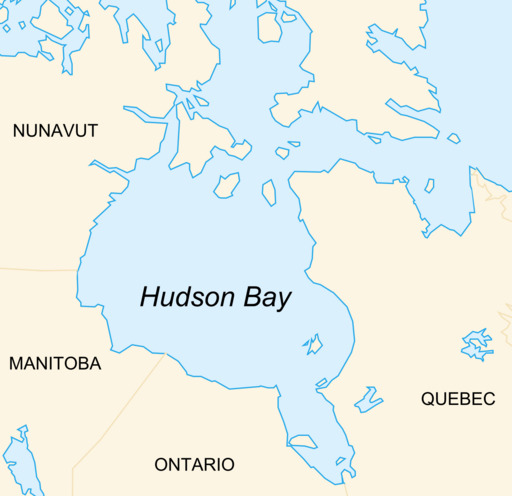
The Blackfeet Confederacy is composed of three groups: the Piegan, Siksika, and Kainai.
The tribe traces its history back to the region near Hudson Bay and even as far east as the present-day border area between Maine and Canada. By the 13th century, the tribe began moving north and west in search of more land.
Later, British traders around James Bay pushed them further west. Eventually, they settled around the Great Lakes area. Having to compete with neighboring tribes for resources, they continued westward, eventually settling on the northern great plains of Montana, Saskatchewan, and Alberta.
Here, they adopted the nomadic lifestyle of the Plains Indians, following the bison herds and gathering berries, roots, and other forage for sustenance. Their lives revolved around the bison, as well as their sacred traditions.
Eventually, they established themselves as one of the most powerful and feared warrior tribes of the northern Great Plains, occupying a territory that stretched from Edmonton, Alberta in the north to Yellowstone National Park in the south and from Glacier National Park in the west to the Black Hills in the east.
Life on the Great Plains
While the Blackfeet Tribe adopted many of the typical customs of Plains Indians, they also had a unique set of traditions and customs that distinguished them from other tribes.
Transportation
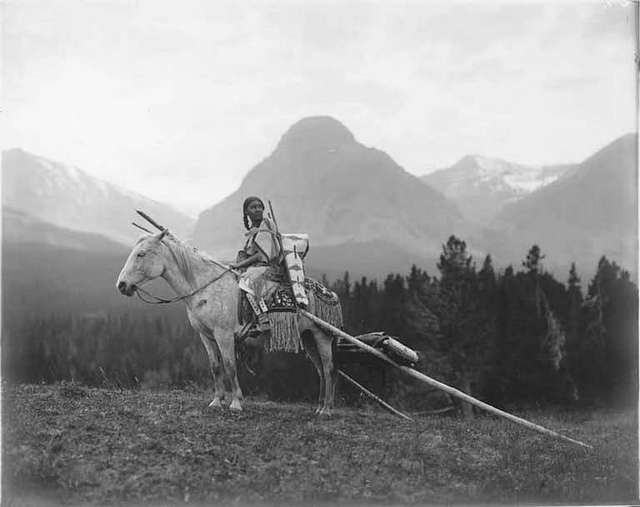
Before they acquired horses, the Blackfeet tribe used dogs and travois to transport their belongings as they moved nomadically across their territory. A travois was an “A”-shaped frame, the narrow end of which they would attach to a dog. On top of it, they would pile their belongings and travel from one destination to the next.
Hunting
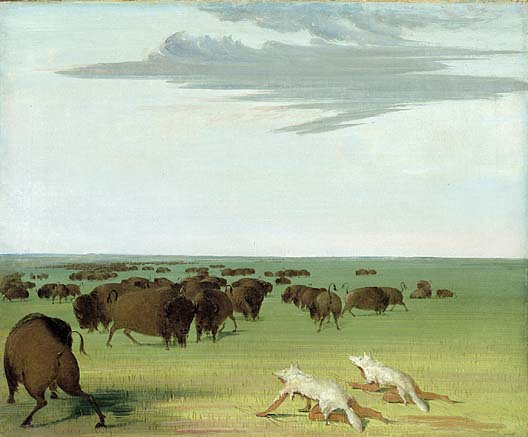
Before horses, they also used traditional methods for hunting, which included the well-known “buffalo jump” and camouflage techniques.
A buffalo jump was a large cliff or steep bluff. The tribe would sometimes set up a “V”-shaped pen at the top and rush the buffalo, steering the frightened herd off the edge of the cliff. The tribe would then hunt the injured bison in the ravine below, carrying as much back to camp as they could carry.
The Blackfeet were the first tribe to use this method, which they called the “Pishkun”. The tribe would also adorn themselves in animal skins to quietly sneak up on bison before attacking them with arrows and spears.
Eating

Back at camp, the women would prepare the meat in various ways, boiling, roasting, or drying it for jerky, which allowed them to preserve the meat for the cold winter months. One of the most well-known Blackfeet foods was pemmican, a mixture of bison meat and wild berries.
They would use every part of the bison. The skins were tanned and used to cover their teepees, which were held up by lodge poles. Skins were also used for clothing, such as robes and mocassins, and they made soap from the lard.
Men and women would fashion utensils, such as sewing needles and tools, from the bones, and the bladder and stomachs were cleaned, cured, and used for storing liquids. Dried bison dung was used as fuel for fires.
Acquiring horses
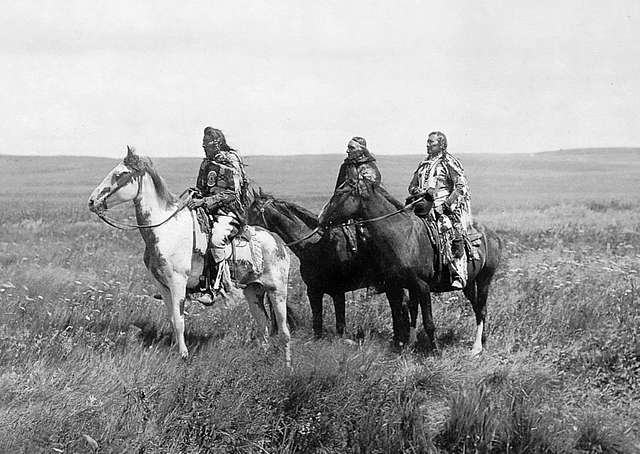
The introduction of horses to the Plains Indians radically transformed their lives. When the Blackfeet Tribe acquired horses, they suddenly had a much faster, stronger means of transportation that could carry more weight. Horses also revolutionized the Blackfeet’s hunting technique.
Soon, horses became a prized commodity for the Blackfeet and a symbol of wealth. However, the tribe’s wealth was not measured in the size of their horse herd, but in how much they were able to give away, as the sole purpose of property among the Blackfeet and other tribes was to share it with others.
Horses became a form of currency for the Blackfeet, used to pay medicine men and craftsmen and as gifts to the needy. Not only were horses a symbol of wealth, they soon became a necessity for survival. As a result, inter-tribal raids and horse theft increased.
War with neighboring tribes
The Blackfeet would often travel hundreds of miles on raids, bringing young men along with them. If it was their first raid, the tribe would give the boy a silly name, only to be replaced by an honorable name once the raid was finished.
To rise in social status, tribesmen had to fulfill a “counting coup”, or a brave act, usually done to an enemy. Counting coups included:
- Stealing of a gun from an enemy or touching him directly
- Stealing lances, bows
- Freeing tied horses from an enemy
- Scouting for a war party
And on and on.
Greatest enemies
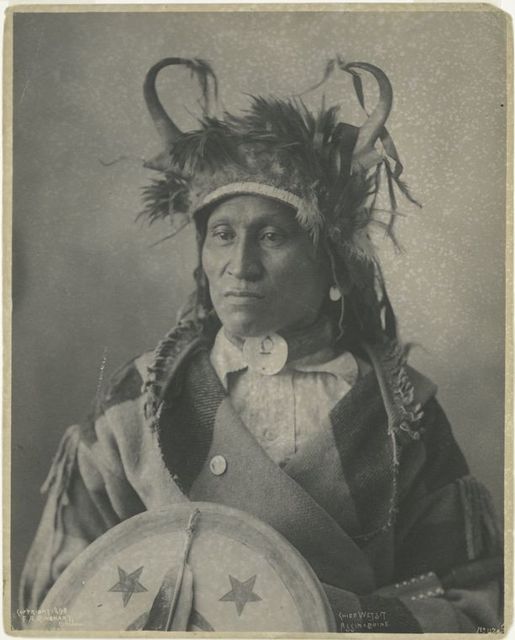
The Blackfeet Tribes faced several main enemies – the Crow, Cheyenne, and Sioux on the Great Plains to the east and southeast, and the Shoshone, Flathead, Kalispel, and Kootenai in the mountain region to the west.
The Blackfeet Tribe’s greatest enemy was the Iron Confederacy, or the Nehiya-Pwat, an allied group of dominating Plains Cree, Assiniboine Tribe, Storey, Slateaux, and Metis to the north and northeast.
The Iron Confederacy grew in numbers and territory over the years, integrating more and more tribes over time, such as the Iroquois, Chepewyanm Daneza, and Flathead. The group reached its height of power from 1790 to 1850, a time in which it posed the greatest challenge for the Blackfeet.
During the Buffalo Wars of 1850 to 1870, most of the Blackfeet bands ceded land around present-day Alberta to the overpowering Iron Confederacy.
First contact with European Settlers
Except for a few tragic events, the Blackfeet were mostly peaceful with European explorers. However, they were a serious scourge for the trappers that followed.
Peace with explorers, a scourge for trappers
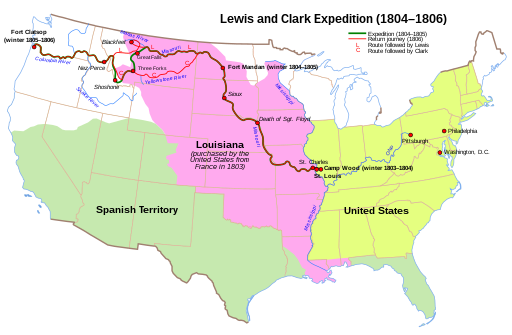
The Blackfeet’s interactions with the Lewis and Clark Expedition were mostly peaceful, with the exception of one event in 1806 which occurred when the Corps was on their way back form the Pacific and crossed through Blackfeet Territory.
After making peace with a local group of Blackfeet, they camped together that night. A scuffle broke out in the morning when they learned that the tribesmen were trying to steal the expedition’s guns and horses. Two of the Blackfeet didn’t survive.
Despite rare occurances such as these, the Blackfeet mostly remained peaceful with expeditioners. However, their tolerance of trappers was a different story.
When John Colter, a former member of the Lewis and Clark expedition, returned for a trapping trip on Blackfeet territory after the expedition, he barely escaped a Blackfeet ambush.
Increased trade
Politics shifted throughout the 1820s and 1830s due to the emergence of horses and guns.
The Blackfeet set aside some of their cultural prohibitions and environmental protections, turning to large-scale trapping of the enormous local wildlife populations. They increased trade with local European trading firms across Canada, such as Hudson’s Bay Company (HBC).
American trading posts later emerged on Blackfeet territory, such as Fort Piegan (1831) and Fort McKenzie (1833), as the Blackfeet increasingly turned to the Americans for their more attractive trading terms.
However, contact with the Europeans also brought about deadly plagues from smallpox and cholera outbreaks that greatly weakened the tribe.
Indian wars
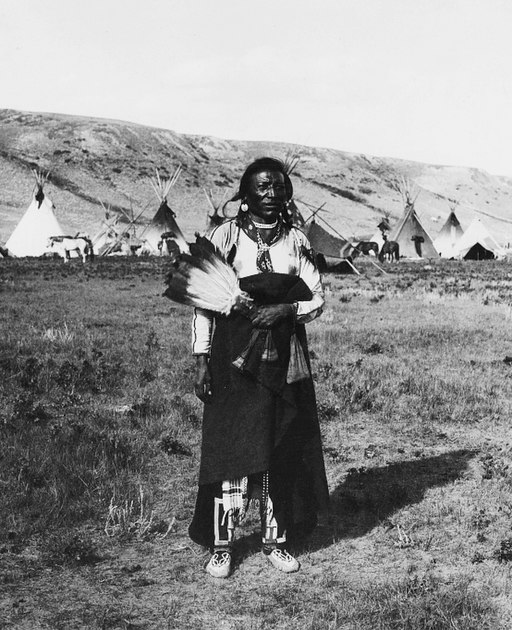
The Blackfeet Tribe generally stayed out of the Indian Wars that raged between local tribes and the U.S. Army throughout the centuries of European colonization of North America.
Throughout the Indian Wars, the Blackfeet garnered a positive reputation among the settlers, especially Queen Victoria back in England.
Events like the Marias Massacre and the Blackfeet Tribe’s good standing with the Northwest Mounted Police (NWMP) encouraged the tribe to stay out of the wars with the settlers.
During the height of the Indian Wars, when the Lakota were battling the U.S. Army, the Lakota sent runners to the Blackfeet to ask them to join the fight. Chief Crowfoot, a highly influential Blackfeet Chief, dismissed the runners and threatened to join the NWMP if they asked again.
However, the Blackfeet Tribe ultimately shared the same fate as other tribes who were eventually conquered and assimilated by the U.S. government.
Encroachment and colonization (late 1800s)
Despite remaining neutral throughout the Indian Wars, the late 1800s for the Blackfeet were marked by shrinking lands, shrinking bison populations, and dependence on inconsistent and unreliable government-provided food supplies.
Settlers were moving in on Blackfeet territory and federally-hired hunters were quickly exterminating the bison populations across the Great Plains, depriving the tribes of their primary source of sustenance.
The Blackfeet tribe quickly became reliant on food supplies from the U.S. government.
A series of failed treaties and agreements with local tribes forced the Blackfeet to continuously cede more territory to the U.S. government. We detail the failed treaties and periods of strife for the Blackfeet throughout the late 1800s below:
Lame Bull Treaty 1855
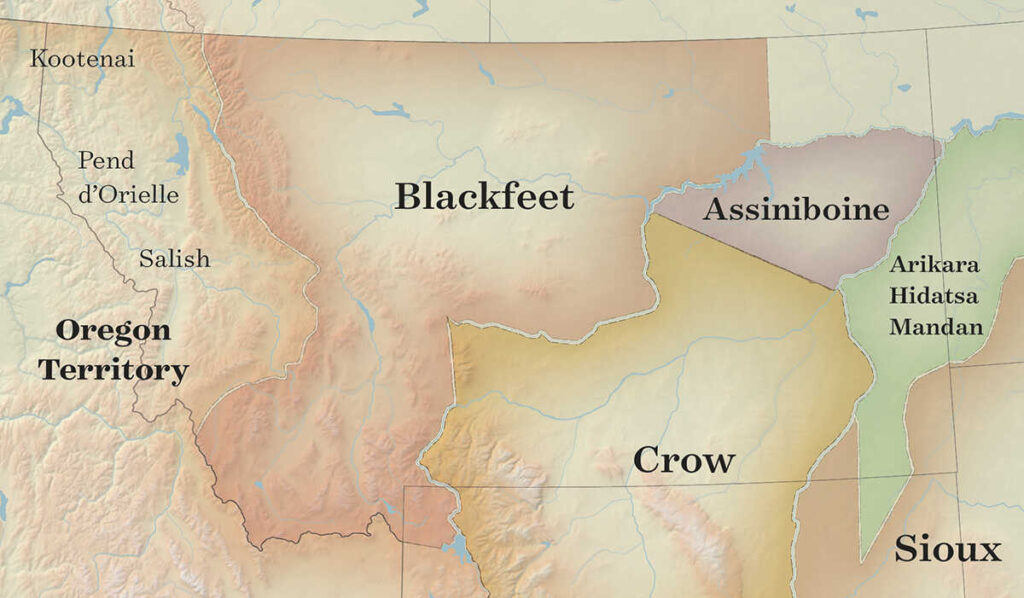
The Lame Bull Treaty forced the Blackfeet onto one of the first officially designated Blackfeet territories.
Under this treaty, Blackfeet territorial boundaries ran east-west from Glacier National Park to Fort Peck along, and north-south from the Canadian border, along the border of Assiniboine and Crow territories in eastern Montana, down to Yellowstone National Park.
The Blackfeet agreed to the treaty in exchange for $20,000 annually in goods and services. The treaty also permitted settlers to reside and travel through the native hunting territories and for the construction of roads, military posts, telegraph lines, and Indian agencies on these native lands.
Unratified 1865 treaty
Shortly after, an unratified 1865 treaty ceded 2,000 miles² (5,180 km²) of Blackfeet territory south of the Missouri River, reducing the tribe’s territory by roughly half.
Their tribal territory now lay strictly between the Missouri River and the Canadian border, stretching from Glacier National Park to the western tip of Fort Peck Reservoir.
Final war with the Iron Confederacy 1870
As bison populations dwindled, bison became scarce, leading hungry tribes to raid other tribes and European settlements.
In 1870, the Iron Confederacy made one last attempt to take one of the last bison-populated lands from the Blackfeet.
The Iron Confederacy was not successful, and the hunger they faced in the following winter forced them to make peace with the Blackfeet.
Great Northern Reservation 1873

In 1873, the federal government again took more territory from the Blackfeet and other tribes, establishing the Great Northern Reservation across much of northern Montana – between the Canadian border and the same southern border that the 1865 treaty established along the Missouri River.
This move grouped the Blackfeet, Gros Ventre, and River Crows onto the same land.
Executive orders of 1874, 1875, and 1880
Next, an executive order in 1874 took more territory from the Blackfeet and other tribes across Montana. The land was returned in 1875 but taken back again in 1880.
Brutal winter of 1883 to 1884
The winter of 1883 to 1884 was an especially brutal winter for the Blackfeet Tribe. The bison were gone and the tribe was fully dependent upon government food supplies that didn’t arrive. 600 Blackfeet Tribe members perished.
Sweet Grass Hills Treaty of 1888
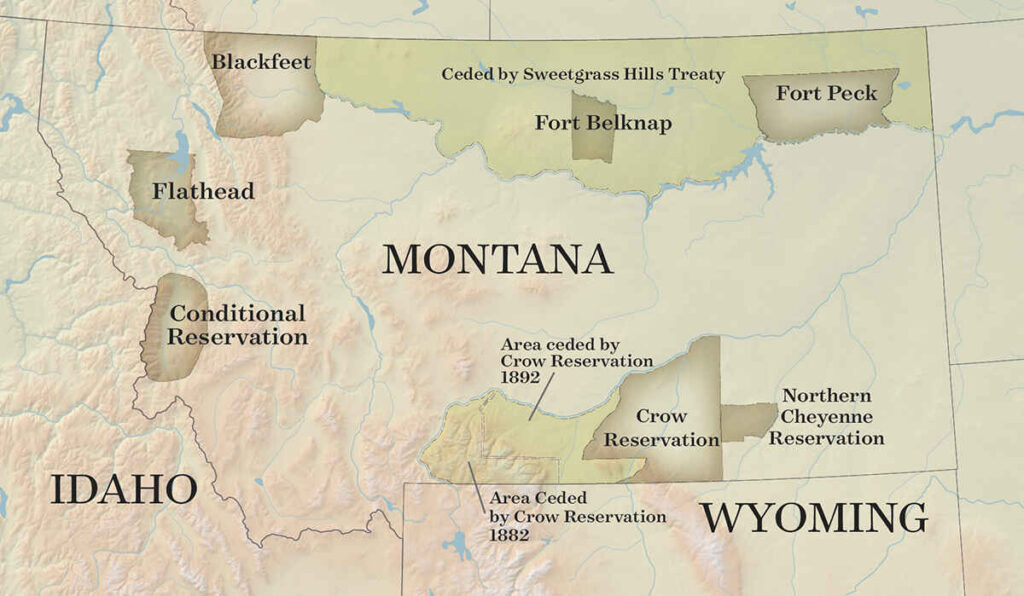
The Sweet Grass Hills Treaty of 1888 split the Great Northern Reservation into three smaller reservations, with the Blackfeet agreeing to live in a small territory occupying the westernmost region of their traditional lands, near present-day Glacier National Park.
The Blackfeet Reservation boundaries at this time closely resembled today’s reservation boundaries, save for a strip that was ceded to Glacier National Park in 1910.
The Blackfeet Reservation under this treaty stretched from the peaks of the Continental Divide in present-day Glacier National Park across the rolling hills east to present-day Cut Bank.
The Gros Ventre and Assiniboine were forced onto a small reservation near the Milk River, called the Fort Belknap Reservation, and the Sioux and other Assiniboine were forced onto a reservation near Fort Peck, called the Fort Peck Reservation. The Fort Peck reservation boundaries have remained the same ever since.
This treaty ceded 17.5 million acres to the U.S. government.
Ceding land to the Lewis & Clark National Forest 1896
In 1896, Chief Whitecalf agreed to cede an 800,000 ft² (3,200 km²) strip of land within the Blackfeet Reservation’s boundaries along the Continental Divide to the federal government.
The federal government incorporated it into the Lewis and Clark National Forest. The agreement maintained that the Blackfeet would retain land use rights over the strip of land, primarily for hunting.
Ceding more land for Glacier National Park in 1910
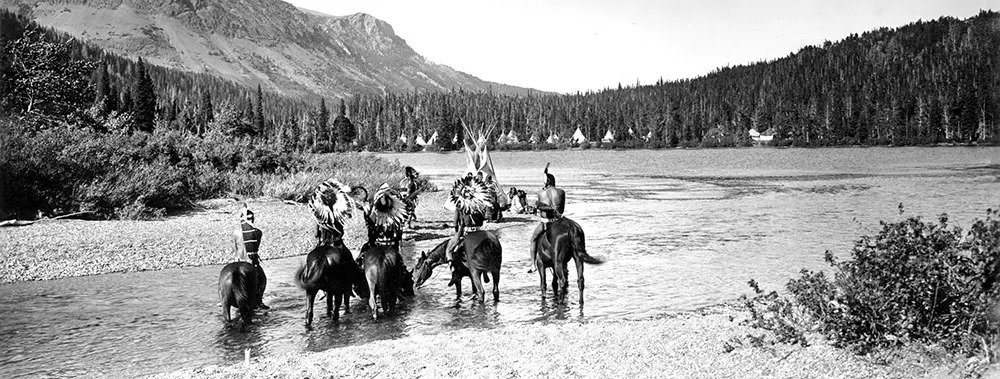
Roughly 14 years later, the federal government unilaterally took this strip of land from the Blackfeet Reservation, cancelled tribal land-use rights, and fully incorporated it into Glacier National Park.
Allotments and assimilation (1890s to early 1900s)
Throughout the 1890s and early 1900s, the federal government took steps to further control the Blackfeet’s way of life and connection to their ancestral culture.
The U.S. government broke up communal tribal lands on the reservation, allotting small parcels to individual families. The allotments proved too small for farming on the arid plains, and the famlies ultimately sold their allotments to pay taxes they owed to the federal government.
In an attempt to fully assimilate native populations into the European way of life, the federal government then dismantled tribal governments and established boarding schools for children.
In the boarding schools, the children were forbidden from speaking their native tongue, participating in traditional customs, or wearing traditional dress.
This traumatizing period of assimilation decimated the tribe.
Indigenous Reorganization Act of 1934 (turning back some of the damage)
The 1934 Indigenous Reorganization Act under Franklin D. Roosevelt finally revoked much of these assimilation regulations, returning tribal rights to practice traditional customs and establish their own governments.
After 1935, members of the Blackfeet Indian Reservation wrote and passed their own constitution and established an elected representative government.
Blackfeet Indian Reservation today

Today, the Blackfeet Indian Reservation occupies roughly 1.5 million acres (607,028 ha) of the tribe’s ancestral land in northwestern Montana, including the beautiful rolling hills that stretch eastward from Chief Mountain along the edge of Glacier National Park.
The Blackfeet Indian Reservation has the same boundaries it was left with after the 1910 establishment of Glacier National Park.
Today, the band living on the Blackfeet Reservation in Montana are a Piegan branch, while the others – the Siksika, Kainai, and another Piegan band – reside on reservations in Alberta, Canada.
The reservation includes the National Bison Refuge, museums, and the annual North American Indian Days event.
Learn more about the native cultures of Montana
- History of the Pend d’Oreille Tribe [CONDENSED]
- The history of the Crow Indian tribe [CONDENSED]
- History of the Northern Cheyenne Tribe [CONDENSED]
- History of the Bitterroot Salish Tribe [CONDENSED]
- The 11 Native American Tribes that lived in Montana before colonists arrived
header image: Beinecke Library, CC BY 2.0 DEED (cropped)


